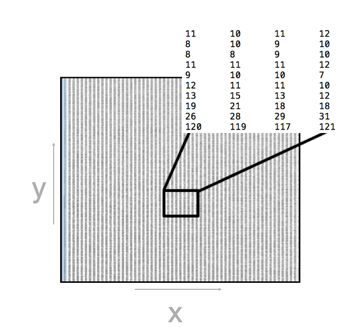Pixels
Learning Objectives
After completing this lesson, learners should be able to:
Examine the values of pixels in an image.
Motivation
Images are very often composed of pixels. Pixel stands for “picture element”. In 3-D, a pixel is sometimes also called a voxel, which stands for “volume element”. To analyse images it is very important to know how to examine the pixels (voxels) in an image.
Concept
graph TD
Im("Image") -->|has many| P("Pixel")
P -->|has| V("Value")
P -->|has| I("Indices")
P -->|aka| V("Voxel")
P -->|can have| S("Size")

Activity
Explore the values, indices (and sizes) of pixels in an image.
Show activity for:ImageJ GUI
Explore pixel values and indices
- Open image: xy_8bit__nuclei_noisy_different_intensity.tif
- Explore different ways to inspect pixel values and indices
- Check where the lowest pixel indices are in the displayed image: * Most commonly: Upper left corner, which is different to conventional coordinate systems.
Explore pixel sizes
- Open image: xyz_8bit_calibrated_anisotropic__mri_head.tif
- Check the pixel sizes (calibration) of this image
- Explore how image calibration affects spatial measurements, e.g.,
- Measure the distance between two pixels in the image
- Measure the size of an image region
- Appreciate that image calibration might be neccessary, e.g.
- 3D distance measurements
- Appreciate that image calibration can be confusing, e.g.
- not consistently used in image filter parameter specification
Formative assessment
True or false? * The lowest pixel index of a 2D image always is [1,1]. * When looking at a 2D image, the lowest pixel indices are always in the lower left corner.
Follow-up material
We recommend reading these modules next:
Learn more: